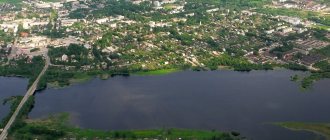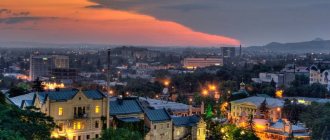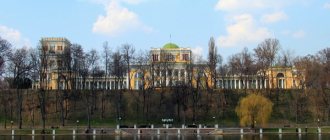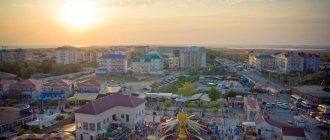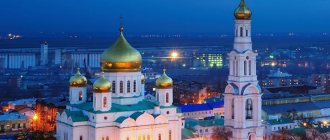- August 22, 2018
- Attractions
- Oleg Petrov
Everyone who finds themselves in this city is interested in questions about where to go in Bryansk. This is an ancient Russian city, in which there is something to see and where to visit in order to get a full impression of it. In this article we will talk about the history of the regional center and places that are definitely worth visiting.
City `s history
Before you tell us where to go in Bryansk, you need to tell us about the history of the city itself, especially since there is something to tell. The city was first mentioned in the famous Ipatiev Chronicle in 1146 under the name Debryansk. The modern name of Bryansk came from it.
Moreover, the year of its foundation is considered to be 985. It is not possible to establish exactly when the first settlement appeared in this place. In the 70s, large-scale excavations were carried out on the Chasha Kurgan, which indicated that the city existed in this place already in the last quarter of the 10th century. Based on these data, scientists agreed to consider 985 as the year of its foundation.
It is worth noting that for many years the dense forests of the Bryansk region actually separated the Russian civilization that was emerging at that time from Zalesye, which is what the territory of the modern Bryansk region was then called. Only during the reign of the Kyiv prince Vladimir Monomakh was a road built through these forests, which contributed to the Slavic colonization of North-Eastern Rus'. The city, which was originally based on the Chashin Kurgan, was then moved to Pokrovskaya Mountain. Presumably, after the Tatar-Mongol invasion.
During the times of Ancient Rus', the city was part of the Chernigov principality, and when Chernigov was destroyed by the Tatars in 1239, its center was moved to Bryansk, which mostly survived. This is the history of the emergence of the Bryansk Principality. Roman Mikhailovich became its first prince. However, the principality did not last long, Roman's son Oleg became a monk, after which both the Chernigov and Bryansk tables were free. After this, the city came under the protectorate of the Smolensk princes.
In 1310, the Tatars reached Bryansk and almost completely devastated it. In 1356, the city was annexed to the Grand Duchy of Lithuania through the efforts of Prince Olgerd. Ivan III managed to return it to the Russian state only in 1500. During the war between Russians and Lithuanians in the 16th century, Bryansk was a powerful and reliable stronghold of Russian forces. Over the next many decades, this city remained a kind of bone of contention between the Russian state and the Polish-Lithuanian Commonwealth. Its name appeared in almost every peace treaty that the parties regularly concluded between themselves.
Religious sites
Bryansk Cathedral in the name of the Holy Trinity
Address: Lenina Avenue, 58 /1 Opening hours: 09:00-18:00
The Bryansk Cathedral occupies an area of one thousand square meters, so during services it can accommodate 3 thousand people.
The temple acquired its modern appearance only at the beginning of the 21st century - the original building was destroyed in 1968, after which work on its restoration continued for many years.
The temple houses the relics of the Venerable Prince Oleg of Bryansk, from whom pilgrims ask for health and well-being.
Spaso-Grobovskaya Church
Address: Lenina Avenue, 98 Opening hours: 09:00-18:00
One of the oldest churches in Bryansk, which was built more than 100 years ago.
The first wooden church built on this site dates back to the 13th century. Old books say that the church stands on the graves of two local priests - Nathanael and Nektarios.
The church building was used for a long time for other purposes, but in 1992 it was reconstructed and returned to the possession of the diocese. Since 1993, religious services have been held there regularly.
Church of the Resurrection of Christ
Address: Lenin Avenue, 58 Opening hours : 9:00-18:00
The temple was founded on the site of the wooden building of the Voskresensky nunnery in the mid-18th century. After the church schism, it belonged to the so-called renovationists, and after the revolution it was closed and converted into a household factory.
The second opening of the church dates back to the 40s of the last century, when the Bryansk region was occupied by Nazi troops.
The Church of the Resurrection has preserved paintings and iconostases, which historians attribute to the 19th-20th centuries.
Intercession Cathedral
Address: Pokrovskaya Gora, 2 Opening hours: 9:00-18:00
The Intercession Cathedral is considered the oldest temple in Bryansk and is located in the old part of the city on the high part of Pokrovskaya Mountain. Initially, there was a dilapidated wooden church there, but in 1698, a stone structure was erected with donations from local official Evstrat Alymov.
During its existence, the cathedral was rebuilt several times and given over to the needs of the state. Major restoration took place in the 1970s, and in the early 90s the building was finally returned to the church.
Now the Intercession Cathedral is a two-story building in the Baroque style, showing traces of a large number of reconstructions.
Petro-Paul Diocesan Convent for Women
Address: st. Kulkova, 14 Phone: +74832646946 Opening hours: 8:00-19:00
The monastery was founded in 1275 by the famous spiritual and secular figure Oleg Bryansky, experienced several devastations, and in 1760 finally fell into decay.
In 1833, the fate of the monastery was taken over by the city elite of Bryansk - with the support of local merchants the Semykins, it was revived as a women's monastery. After the revolution, the temple was abolished, but the cathedral, hospital and several cells were preserved from the previous buildings.
The monastery was opened in 2002, and today it is operational.
Time of Troubles
During the Time of Troubles, Bryansk was twice attacked by troops controlled by False Dmitry II. At first, it was burned down by the local residents themselves so that the “Tushino thief” would not get anything, but by the end of 1607 it was almost completely rebuilt, this time it successfully withstood the siege of the impostor’s army.
It is noteworthy that even despite the constant military threat, the city grew and its population increased. If in 1616 there were only 497 permanent residents, then six years later, according to the records of Prince Dolgorukov, there were more than a thousand adults of military age capable of fighting.
Researchers have always noted the favorable geographical and economic position of the city. Starting from the 12th century, it was actually at the center of important trade routes that connected Moscow and Little Russia. Due to this, trade boomed here.
During the reign of Peter I, the city was fortified, and a shipyard was even founded on the Desna, from which the ships of the Bryansk flotilla launched, fighting against the Turks. Since 1783, an arsenal for field and siege artillery has been based in Bryansk.
Moreover, since 1709 it has been part of the Kyiv province, then it came under the protectorate of Belgorod, and in 1778 it became part of the Oryol governorship. In the 19th century, Bryansk became the center of a large industrial region of the same name. Since 1873, mechanical, rail-rolling and other factories have been operating here. At the very end of the 19th century, a railway junction was formed.
After the October Revolution, Bryansk became the center of the province of the same name, and in 1930 it became a city of regional subordination as part of the Western Region. During the Great Patriotic War, a powerful partisan movement operated here after it was occupied in October 1941. The number of partisans in the Bryansk forests reached 60 thousand people. At the same time, most of the civilians were virtually exterminated.
The city was liberated on September 17, 1943; today this date is celebrated as City Day. The Bryansk region within its modern borders was formed in the summer of 1944.
Parks and monuments
Park Museum named after A.K. Tolstoy
Address: Gagarina Boulevard, 33
The park was opened in honor of the 150th anniversary of the famous playwright Alexei Tolstoy, a native of the Bryansk region. It was founded in the 30s on the site of the old city cemetery, which was moved to another location.
The park includes several zones - a collection of ancient and modern wooden sculptures, as well as a recreation area with attractions and a cafe.
Some wooden sculptures appeared in the 60s of the last century.
Slavyanskaya Square
The place is located on the banks of the Desna River and is an area with a lot of greenery and recreation areas. The Friendship fountain gushes in the center, and next to it there is a concert hall with the same name.
In the future, it is planned to install a temple and a monument to Cyril and Methodius on Slavyanskaya Square.
There are many hotels near the embankment where city guests can stay.
Monument to Alexander Peresvet
Address: Pokrovskaya Gora
Alexander Peresvet is one of the legendary participants in the Battle of Kulikovo, a monk of the Trinity-Sergius Lavra and a native of Bryansk. The monument to the fallen hero was erected on Pokrovskaya Hill, one of the highest points of the city, and its opening took place in 1895.
The memorial complex is a sculpture of a monk on a horse, and next to him sits the singer Bayan with a harp - a hero who inspired warriors to fight. Behind the backs of the characters there is a stele that resembles a church, as well as a figure of a woman, personifying the homeland.
Stele "City of Military Glory"
Address: central park, Mound of Immortality
The monument dates back to 2010 and was opened in honor of the awarding of the title of “City of Military Glory” to Bryansk. The height of the monument is more than 10 m, and its surface is decorated with a double-headed eagle cast from gilded bronze.
The stele stands on the Mound of Immortality, recalling the courage of the inhabitants of Bryansk during a fierce confrontation with the enemy.
Hatsun
Coordinates: 53.134033N, 34.637367E Address: Karachevsky district, Khatsun village How to get there: the distance from Bryansk to Khatsun is 28 km
The Khatsun memorial complex is often called the sister of Khatyn - in 41, 318 people, including minor children, were burned and executed here.
In 1977, on the site of the village, a museum and a complex of 28 steles were erected in memory of the victims who died in the Bryansk region during the Great Patriotic War.
The museum's exhibition consists of two parts; one tells about the everyday life and peaceful life of a village destroyed by the Germans; and the second tells the story of the executions and mass shootings that took place in this area.
“Partisan Glade” and exhibition of military equipment
Coordinates: 53.23519 N 34.59400 W How to get there: the complex is located 22 km from Bryansk in the direction of Moskovsky Prospekt
The complex is located in the forests on one of the banks of the Snezhet River. During the Great Patriotic War, there was a secret clearing here - a meeting place for members of underground organizations and partisan detachments.
In 1969, a monument was erected on the site of the clearing, which was later expanded into a memorial. The complex consists of a museum, a wall of memory, obelisks, an eternal flame and an exhibition of military equipment. It presents armored personnel carriers, howitzers and other equipment of the war and post-war period.
Museums
When thinking about where to go in Bryansk, the first thing that comes to mind, as in any other city, is museums. It is here that you will be able to clearly get acquainted with the history of the city and find out all the details that interest you. The largest in the city is the Bryansk United Museum of Local Lore.
It has been operating since 1921. Moreover, during the Second World War it was plundered, almost the entire collection was lost. After the war, they began to assemble it almost anew, so 1949 is considered its second birthday. Here's where to go in Bryansk to thoroughly learn everything about this city. The museum has many branches - military-historical, local history and even literary and musical. In 2021, it included a local planetarium.
Judging by the reviews and advice of experienced travelers, the most interesting branch is the memorial complex called “Partisan Glade”. It is based on the place where in September 1941 there was a general gathering of all partisan detachments, which began their combat journey from here. The memorial complex was opened in 1969. It includes a 20-meter central obelisk, a stele with a map of the partisan movement, a museum of the history of the partisan movement with a diorama “The Explosion of the Blue Bridge,” and a memory wall with the names of eight thousand partisans who died on Bryansk soil.
Also of interest is the museum of the Tkachev brothers, famous Soviet painters who worked in creative tandem.
"Bryansk Forest"
Until recently, there was the first professional forest museum in Russia, which was called “Bryansk Forest”. It was located in the park-museum named after Alexei Konstantinovich Tolstoy.
There were plaster maps and diagrams of plants and fauna, photographs and stuffed representatives of the Bryansk fauna, and an exhibition with forestry and production information. Interesting and educational excursions were organized here, which were accompanied by the demonstration of color slides and videos on environmental topics.
In a separate room, four dioramas were presented, each of which was dedicated to a specific time of year. The main highlight of this museum was a musical and literary show based on Marshak’s fairy tale “12 Months”.
In 2009, there was a fire at the museum. The fire covered a large area, so the fire was assigned the highest category of complexity. The fire was finally extinguished in about four hours. There were no deaths or injuries, but the museum's property and exhibits were almost completely destroyed. The examination concluded that it was arson. The remains of the building were demolished, and now the museum has been completely liquidated, although activists still advocate for its revival.
Attractions in the surrounding area
Bryansk Forest Nature Reserve
Coordinates: 52.4933, 33.991 Phone: +74835325774 Cost: the price of excursions depends on the topic and duration, and ranges from 60-100 rubles. How to get there: the reserve is located 1.5 km from the Nerussa station
The reserve is considered one of the smallest in Russia, but in terms of diversity of flora and fauna it is not inferior to large natural sites. It was founded in 1987 on the territory between the Nerussa and Desna rivers.
The reserve offers individual and group excursions that allow you to see rare species of plants and animals, including the black stork, a “Red Book” bird.
Tourists can stay in one of the hotel rooms and spend time in nature.
Svensky Monastery
Address: Suponevo village, st. Moskovskaya, 189b Phone: +74832922074 How to get there: by personal or public transport to the Svensky Monastery stop
Monastery, which is located in the village of Suponevo. According to legend, it was founded by the Bryansk prince Roman Mikhailovich, and the Pechersk Icon of the Mother of God itself showed him the place for the monastery.
The first mentions of it date back to the 16th century, when Ivan the Terrible ordered two stone churches to be built in its place. After the revolution, the monastery was abolished and subsequently blown up.
The surviving buildings were returned to the diocese, and since 2014, restoration of the destroyed part of the monastery has been underway.
Museum-reserve of F. I. Tyutchev “Ovstug”
Address: Zhukovsky district, village. Ovstug, st. Tyutcheva, 30 Opening hours: 9:00-17:00, Saturday 9:00-19:00, closed Monday Phone: 8(48334)93671 Cost: 100 rub. for adults, 70 rub. for students
On the banks of the Ovstuzhenka River there was once an estate of the noble Tyutchev family, where the famous poet was born in 1803.
His ancestor received the lands along with the bride's dowry and founded a house with a church on them. In the post-revolutionary period, the estate fell into disrepair, and the buildings were dismantled for building materials.
In 1957, a museum was founded in the building of a local school, which has more than a thousand original exhibits. And already in 1985, the main house of the estate was recreated, next to which there are linden alleys and a mill.
Literary and Memorial Museum of A.K. Tolstoy
Address: Pochepsky district, Krasny Rog village Opening hours: 9:00-18:00, closed Monday Cost: 150 rub. for adults, pensioners 70 rub., students and schoolchildren 50 rub.
The estate near the village of Krasny Rog was founded in the 18th century by Count Razumovsky. After changing several owners, it passed to Alexei Tolstoy in 1836.
The house with a rich library and picturesque surroundings became the writer’s favorite abode. Fet, Polonsky, Turgenev and other famous writers were there.
If you have not yet chosen where you will live and want to save money when booking, we recommend using the RoomGuru service. Firstly, it contains hotels, apartments and guest houses from many different booking systems, so you won’t miss out on a worthwhile option. Secondly, you can immediately compare prices for one place in different services and book where it is cheaper (this is not always Booking!).
Cultural recreation
Those who come on vacation or a business trip have something to do in Bryansk. There are a large number of cultural institutions here, which we will talk about in this article.
First of all, you should visit the Bryansk Regional Drama Theater named after Alexei Konstantinovich Tolstoy, which has been operating since 1926. The troupe includes many famous artists. The poster presents modern and classical works, for example, “Dead Souls” by Gogol or “God’s Dandelions” by Ivanov. This is where you should definitely go in Bryansk.
Also in the city there is a puppet theater, a theater for young spectators, a youth theater "Adults and Children", a children's musical theater "Orpheus", a regional philharmonic society, and a circus with almost two thousand seats.
You can see all the world's film premieres in Bryansk cinemas. This is the place where it seems possible to go with a girl in Bryansk at the very beginning of a romantic evening. Interestingly, two of them still remain municipal.
- “Salute” is located at Pushkin Street, 36;
- “Victory” - Mayskaya Strike Street, 5;
- “Panorama” - Third International Street, 8;
- “Paradise Park” - Krasnoarmeyskaya street, 100;
- "Luxor" - Obezdnaya street, 30;
- Cinema Club - Krasnoarmeyskaya street, 71.
Boulevard named after Gagarin
This is the main pedestrian street of the city, which tourists often call “Bryansk Arbat”
There is not such an abundance of establishments and singing musicians here as in the capital. But you can leisurely take a closer look at the city, see the Gagarin memorial , the musical fountain . A long staircase will lead through a picturesque square to Kalinina Street. Tourists are impressed by the high slope of the street. It is especially beautiful here in the evening when the city lights come on.
Boulevard named after Gagarin
Park named after Tolstoy
If you are interested in where to take a walk in Bryansk, then feel free to go to the park named after Alexei Konstantinovich Tolstoy. You will definitely like it here. This is the park where you should go first in Bryansk in July. The park spreads over an area of almost three hectares. It attracts many with its stunning collection of wooden sculptures.
Nowadays, it performs all the functions of a modern city park. There are many cafes and restaurants, there is an amusement town, and cultural events and themed festivals are regularly held in summer and spring. Here's where you can go in Bryansk.
Its main distinguishing feature is its wooden sculptures. There are now about 35 of them. The park administration takes care of their safety, taking measures to protect them from rotting and exposure to harmful insects. The most famous local sculptures are “Emelya”, “Desnyanka”, “Bryansk Madonna”, “Prince Roman Bryansky”.
This is a great place to go for a walk in Bryansk.
Mound of Immortality
One of the symbols of the city is the Mound of Immortality. This is an attraction where you should definitely go to Bryansk on the weekend. It is located in the Central Park of Culture and Leisure "Nightingales", opened for the 1000th anniversary of Bryansk.
Externally, it is an artificial earthen embankment, which is made in the form of a pentagonal hill 12 meters high. It is crowned by an 18-meter concrete pylon in the shape of a five-pointed star. This is a must-see place in Bryansk, especially if you are interested in the history of the Great Patriotic War.
It was founded in 1967. The land was brought here from all the hero cities of the USSR, villages and small settlements of the Bryansk region, which played an important role in resisting the Nazis during the Great Patriotic War.
What to see in Bryansk in 1 day
Here is a one-day sequential route, consisting of the most interesting tourist sites, located mainly in the central part of the city:
- Cathedral (Holy Trinity) Cathedral of Bryansk;
- Bryansk Museum and Exhibition Center;
- children's entertainment;
- Intercession Church;
- Bryansk Regional Museum;
- Chashin Kurgan;
- Bryansk State Circus.
Chashin Kurgan
Here's where you should go in Bryansk to get immersed in the ancient history of the city. This is the oldest structure preserved in the city. It appeared in the 11th century in the area of Pokrovskaya Mountain. Here was the Bryansk Kremlin, which had almost five hundred fathoms in perimeter and strong oak walls.
Until the beginning of the 18th century, the Kremlin remained a famous defensive fortress throughout Russia. From here one of the best views of the Desna River valley and the entire city of Bryansk opens.
In total, the Bryansk Kremlin initially had 16 towers, most of which were located directly above the Pyatnitsky moat. The Sudov Tower had direct access to the Sudok River. Only two towers were gates, and the rest were blind.
The central building of the Kremlin is the Intercession Cathedral, at the base of which the so-called Bryansk Arsenal was formed in the 18th century. This is the very historical place where you should definitely go for a walk in Bryansk.
Partizan Square
This is the name of one of the central squares of Bryansk. It is noteworthy that it first appeared on city plans back in 1791 under the name Khlebnaya. But the area in this part of the city was quite specific, so it was not built up for a long time; work began only at the end of the 19th century.
In the modern history of the city, this is the main place where all mass holidays and celebrations are organized, rallies related to the Great Patriotic War, and City Day is celebrated. This is the place where all local residents prefer to take a walk in Bryansk.
There is also a monument to the liberators of Bryansk (soldiers and partisans), which was opened back in 1966. Its basis is the 22-meter-tall Victory Obelisk, in front of which there is a bronze sculptural figure of a warrior.
In front of the central composition there are two more bronze sculptural groups. On the left side are soldiers rushing to attack, and on the right are partisans.
Memorial complex Partizanskaya Polyana
You can get to this place by car or bus. The memorial is located near the village of Belye Berega . The memory of the Bryansk partisans who bravely fought against the fascist invaders is immortalized here. On the territory of the complex there is a museum of military glory , a large amount of military equipment is presented and dugouts and trenches were erected in exact accordance with the structures of those years.
An eternal flame is installed at the memorial as a symbol of memory and gratitude
Tourists are attracted here not only by the history of the hero city, but also by the picturesque surroundings of the memorial.
Here you can also have lunch and relax in numerous cafes if your visit to the complex is prolonged.
Memorial complex Partizanskaya Polyana


